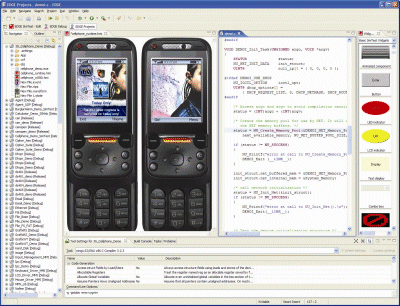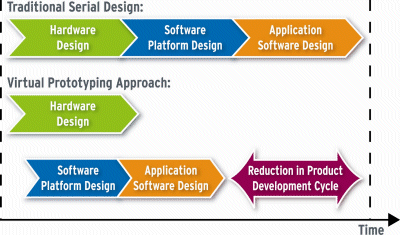System simulation speeds product development
Complete system-level virtual platform provides needed
design time reduction and improves quality
BY LYLE PITTROFF
Mentor Graphics
Wilsonville, OR
http://www.mentor.com
When you think of all the resources available to embedded designers today, the most precious and scarce are always the same — time and money. The microprocessor suppliers who make the first hardware platforms available for evaluation, adoption, cloning, and software prototyping never seem to have enough financial resources, which impacts OEM/ODM development and introduction schedules.
This is especially critical in consumer markets where:
• Product differentiation means an increasing number of projects.
• Each product has increasing feature complexity.
• Feature leaps mean greater adoption rates for new technologies.
• Development schedules and product life cycles become shorter and shorter.
Every company faces the same challenges, whether it’s hardware, software, display, or battery technology. Since the last two items listed above proceed separately and in parallel with hardware/software development, the question remains: how do you parallelize hardware and software development tasks to accelerate product introductions in the midst of continuously increasing complexity? The conclusion, increasingly, is that all developers must have more than the traditional tools in their toolbox.
A complete system-level virtual platform is needed
Many first prototypes perform the basic functions — but run into issues when tested in the full-system environment. Instruction-set simulation (ISS) provides a high-level model of the processor, but doesn’t go to the next step provided by a full-system simulator.
The full-system simulator model incorporates not only the processor, but peripherals, the memory system, and system network connections; and it does so in a more thorough manner modeling the real-use case environment.
The benefits of the full-system approach include:
• Early discovery of system level issues that could cancel or delay the product launch if found too late in the development cycle.
• Early evaluation of new GUI or functional models, or implementation approaches before commencing the actual product design process.
• Starting software development long before hardware becomes available and without incurring hardware cost.
The advantage of a system-level virtual prototyping platform on the product development cycle is shown in Fig. 1 . The most significant gain is that platform software development can begin while hardware design is still in progress. If the new hardware design is an update of a prior design, software design can even start before the new hardware design, but certainly soon after the hardware component choices become known.

Fig. 1. The virtual system-prototyping approach for processor-based systems accelerates the development cycle and improves quality at all levels.
Further, since this type of system simulation can simulate the entire operating system’s application environment (for example, call interface in telcom applications), application developers and independent software vendors don’t have to move beyond the simulation environment. This means they can avoid the delays of hardware bring-up, the cost of multiple hardware platforms, and associated component shortages and delays.
With a virtual prototyping system (see Fig. 2) , developers not only have the ability to validate the drivers behind the buttons, but they can also trace the call through a virtual network connection, which includes capabilities such as simulation of ring tones and the completion of the call at the receiving handset.

Fig. 2. A system-level virtual platform, such as this one from Mentor Graphics, goes well beyond the capabilities of the traditional instruction set simulation approach.
Given that this type of system can also provide fast execution time and rapid turnaround for code modification and retest — faster than hardware platform debug cycles — the system simulation model becomes available to application software developers before the hardware platforms are ready. This can be done without the limitations imposed by finite quantities of development boards.
Full-system simulation: big advantages
Full-system simulator models, such as EDGE SimTest from Mentor Graphics, offer major competitive advantages for companies designing or integrating processor based systems — be it consumer handheld devices, automotive electronics, industrial control, or medical applications. With a system-level virtual platform, developers can start prototyping and testing in a complete system environment much earlier in the development cycle, thus effectively parallelizing the hardware/software development phases. Additionally, a system-level virtual platform enables ISVs to port and validate their software without having to acquire the myriad hardware platforms they must target.
While the concept of host-based prototyping for embedded software is well known in the industry, some system simulator models go well beyond the regular host prototyping setup with advances like:
• A GUI that enables visualization of the embedded device and tracing of software activity.
• A simulation backplane that allows communication between the embedded application instances.
A run-time library that is linked with the embedded application and enables prototyped applications to communicate with the GUI or other application instances.
The advantages of early kickoff of the software development cycle and rigorous testing in the early stages of a project provided by system simulation tools yields a very solid return on investment. ■
For more information on development tools, visit http://www2.electronicproducts.com/Software.aspx.
Advertisement
Learn more about Mentor Graphics





